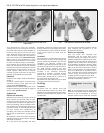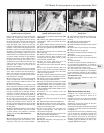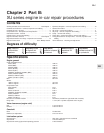
6 Note the fitted depth of the seal as a guide
to refitting the new seal, then punch or drill
two small holes opposite each other in the
seal. Screw a self-tapping screw into each,
and pull on the screws with pliers to extract
the seal. Alternatively, the seal can be levered
out of position using a suitable flat-bladed
screwdriver, taking great care not to damage
the crankshaft shoulder or timing cover.
7 Clean the timing cover, and polish off any
burrs or raised edges, which may have
caused the seal to fail in the first place.
8 Lubricate the lips of the new seal with clean
engine oil, and carefully locate the seal on the
end of crankshaft. Note that its sealing lip
must face inwards. Take care not to damage
the seal lips during fitting.
9 Using a suitable tubular drift (such as a
socket) which bears only on the hard outer
edge of the seal, tap the seal into position, to
the same depth in the timing cover as the
original was prior to removal.
10 Wash off any traces of oil, then refit the
crankshaft pulley and nut. Tighten the
crankshaft pulley nut to the specified torque,
again jamming the flywheel to prevent the
crankshaft rotating.
11 Refit the starter, if removed (Chapter 5A).
12 Refit and tension the auxiliary drivebelt
(Chapter 1).
13 Lower the engine, reconnect the
mounting.
Left-hand oil seal
14 Remove the flywheel as described in
Section 9.
15 Make a note of the correct fitted depth of
the seal in its housing. Punch or drill two small
holes opposite each other in the seal. Screw a
self-tapping screw into each, and pull on the
screws with pliers to extract the seal.
16 Clean the seal housing, and polish off any
burrs or raised edges, which may have
caused the seal to fail in the first place.
17 Lubricate the lips of the new seal with
clean engine oil, and carefully locate the seal
on the end of the crankshaft.
18 Using a suitable tubular drift, which bears
only on the hard outer edge of the seal, drive
the seal into position, to the same depth in the
housing as the original was prior to removal.
19 Wash off any traces of oil, then refit the
flywheel as described in Section 9.
9 Flywheel - removal,
inspection and refitting
3
Removal
1 Remove the clutch assembly as described
for models with the BH 3 transmission in
Chapter 6.
2 Undo the retaining bolts and remove the
flywheel from the crankshaft. If necessary
hold the flywheel stationary using a
screwdriver engaged with the starter ring
gear.
Inspection
3 If the flywheel’s clutch mating surface is
deeply scored, cracked or otherwise
damaged, the flywheel must be renewed.
However, it may be possible to have it
surface-ground; seek the advice of a Peugeot
dealer or engine reconditioning specialist.
4 If the ring gear is badly worn or has missing
teeth, it must be renewed. This job is best left
to a Peugeot dealer or engine reconditioning
specialist. The temperature to which the new
ring gear must be heated for installation is
critical and, if not done accurately, the
hardness of the teeth will be destroyed.
Refitting
5 Clean the mating surfaces of the flywheel
and crankshaft. Remove any remaining
locking compound from the threads of the
bolts and crankshaft holes, using the correct-
size tap, if available.
6 Fit the flywheel to the crankshaft. The
flywheel holes are offset so it will only go onto
the crankshaft flange in one position. Apply
thread locking compound to clean threads,
screw in the flywheel bolts and tighten to the
specified torque.
7 Refit the clutch assembly as described in
Chapter 6.
10 Engine/transmission
mountings - inspection and
renewal
3
Inspection
1 The engine/transmission is supported by
three mountings, two at the timing chain end
and one at the transfer gear end.
2 If improved access is required, raise the
front of the car and support it securely on axle
stands (see “Jacking and vehicle support”).
3 Check the mounting rubber to see if it is
cracked, hardened or separated from the
metal at any point; renew the mounting if any
such damage or deterioration is evident.
4 Check that all the mounting’s fasteners are
securely tightened; use a torque wrench to
check if possible.
5 Using a large screwdriver or a crowbar,
check for wear in the mounting by carefully
levering against it to check for free play.
Where this is not possible, enlist the aid of an
assistant to move the engine/transmission
back and forth, or from side to side, while you
watch the mounting. While some free play is
to be expected even from new components,
excessive wear should be obvious. If
excessive free play is found, check first that
the fasteners are correctly secured, then
renew any worn components.
Renewal
6 It is recommended that one mounting is
renewed at a time after the weight of the unit
has been taken on a jack with a block of wood
as an insulator. Removal and refitting of the
relevant mountings is straightforward once
access has been gained.
7 The battery and tray must be removed
when renewing the left-hand mounting.
8 Tighten the bolts to the specified torque
after renewing the mountings.
2A•10 XV, XW and XY series engine in-car repair procedures
If a suitable tap is not
available, cut two slots into
the threads of an old bolt of
suitable size and use the bolt
to remove the locking compound from
the threads.


















